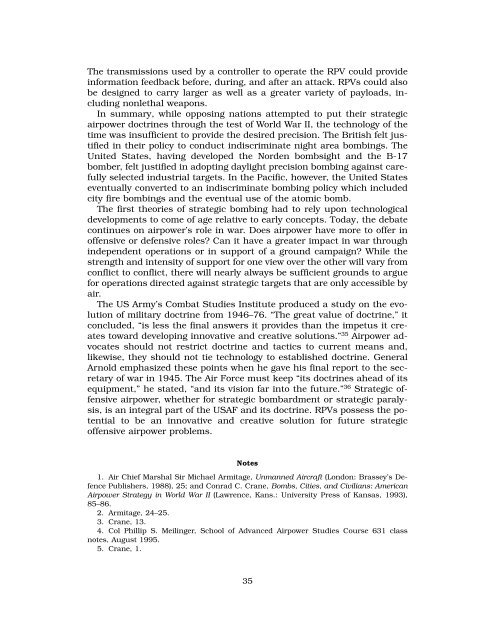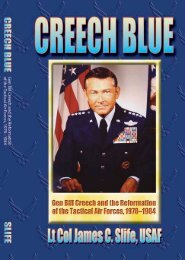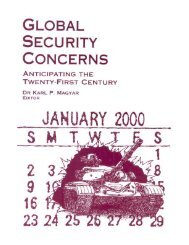Expendable Remotely Piloted Vehicles for Strategic Offensive ...
Expendable Remotely Piloted Vehicles for Strategic Offensive ...
Expendable Remotely Piloted Vehicles for Strategic Offensive ...
Create successful ePaper yourself
Turn your PDF publications into a flip-book with our unique Google optimized e-Paper software.
The transmissions used by a controller to operate the RPV could providein<strong>for</strong>mation feedback be<strong>for</strong>e, during, and after an attack. RPVs could alsobe designed to carry larger as well as a greater variety of payloads, includingnonlethal weapons.In summary, while opposing nations attempted to put their strategicairpower doctrines through the test of World War II, the technology of thetime was insufficient to provide the desired precision. The British felt justifiedin their policy to conduct indiscriminate night area bombings. TheUnited States, having developed the Norden bombsight and the B-17bomber, felt justified in adopting daylight precision bombing against carefullyselected industrial targets. In the Pacific, however, the United Stateseventually converted to an indiscriminate bombing policy which includedcity fire bombings and the eventual use of the atomic bomb.The first theories of strategic bombing had to rely upon technologicaldevelopments to come of age relative to early concepts. Today, the debatecontinues on airpower’s role in war. Does airpower have more to offer inoffensive or defensive roles? Can it have a greater impact in war throughindependent operations or in support of a ground campaign? While thestrength and intensity of support <strong>for</strong> one view over the other will vary fromconflict to conflict, there will nearly always be sufficient grounds to argue<strong>for</strong> operations directed against strategic targets that are only accessible byair.The US Army’s Combat Studies Institute produced a study on the evolutionof military doctrine from 1946–76. “The great value of doctrine,” itconcluded, “is less the final answers it provides than the impetus it createstoward developing innovative and creative solutions.” 35 Airpower advocatesshould not restrict doctrine and tactics to current means and,likewise, they should not tie technology to established doctrine. GeneralArnold emphasized these points when he gave his final report to the secretaryof war in 1945. The Air Force must keep “its doctrines ahead of itsequipment,” he stated, “and its vision far into the future.” 36 <strong>Strategic</strong> offensiveairpower, whether <strong>for</strong> strategic bombardment or strategic paralysis,is an integral part of the USAF and its doctrine. RPVs possess the potentialto be an innovative and creative solution <strong>for</strong> future strategicoffensive airpower problems.Notes1. Air Chief Marshal Sir Michael Armitage, Unmanned Aircraft (London: Brassey’s DefencePublishers, 1988), 25; and Conrad C. Crane, Bombs, Cities, and Civilians: AmericanAirpower Strategy in World War II (Lawrence, Kans.: University Press of Kansas, 1993),85–86.2. Armitage, 24–25.3. Crane, 13.4. Col Phillip S. Meilinger, School of Advanced Airpower Studies Course 631 classnotes, August 1995.5. Crane, 1.35






